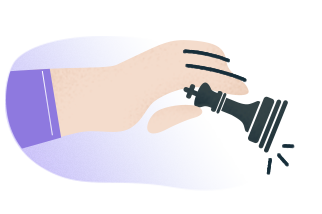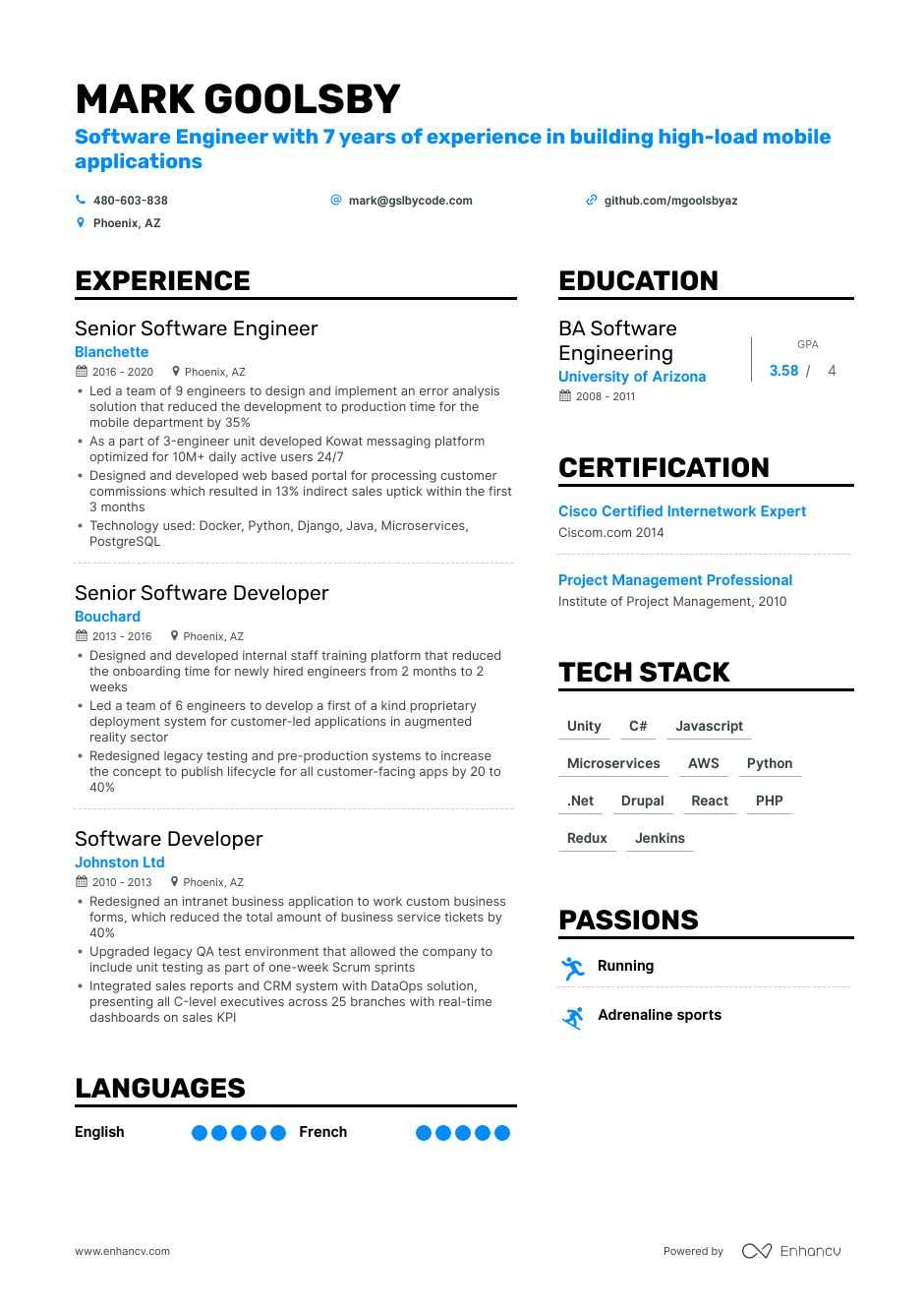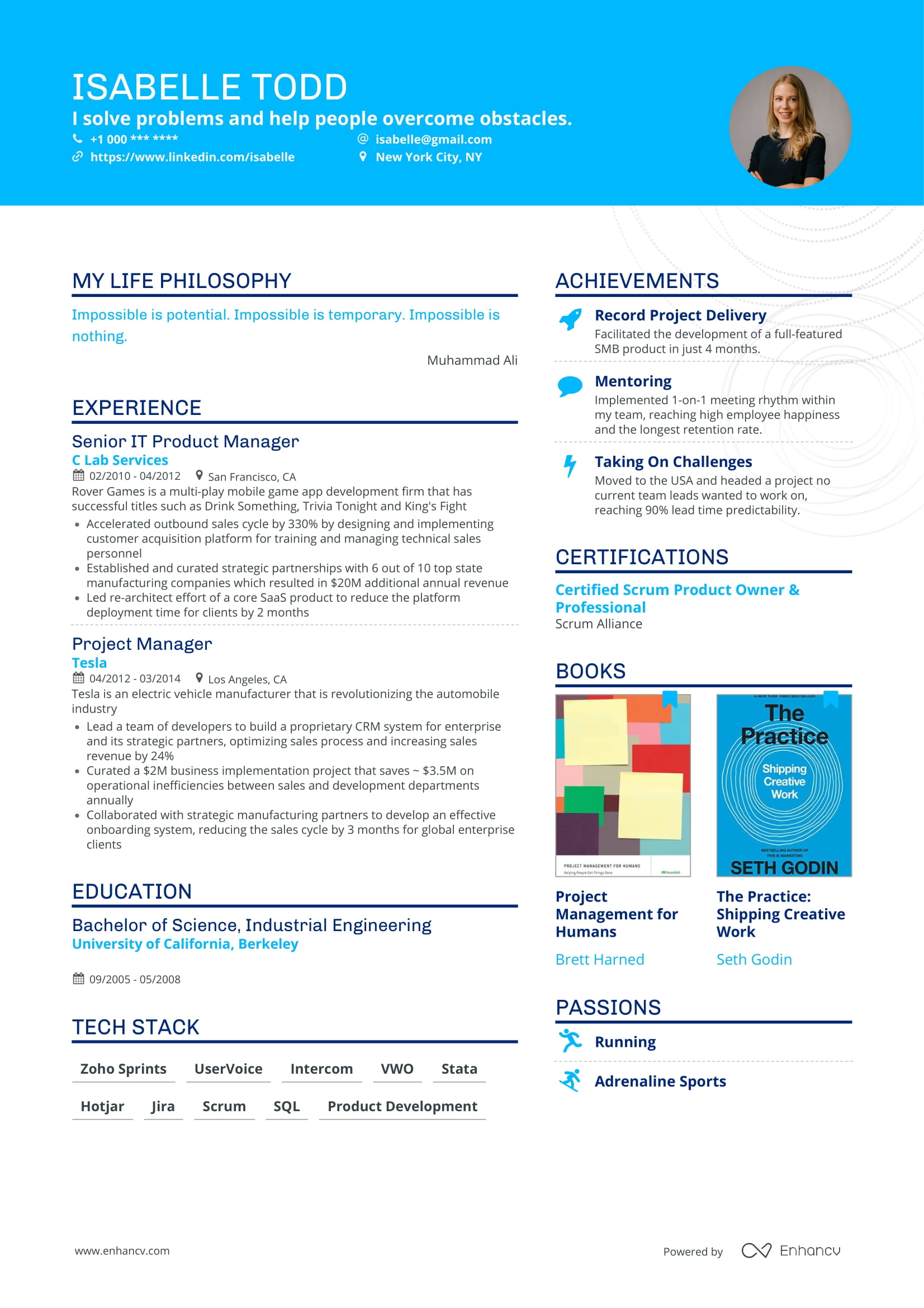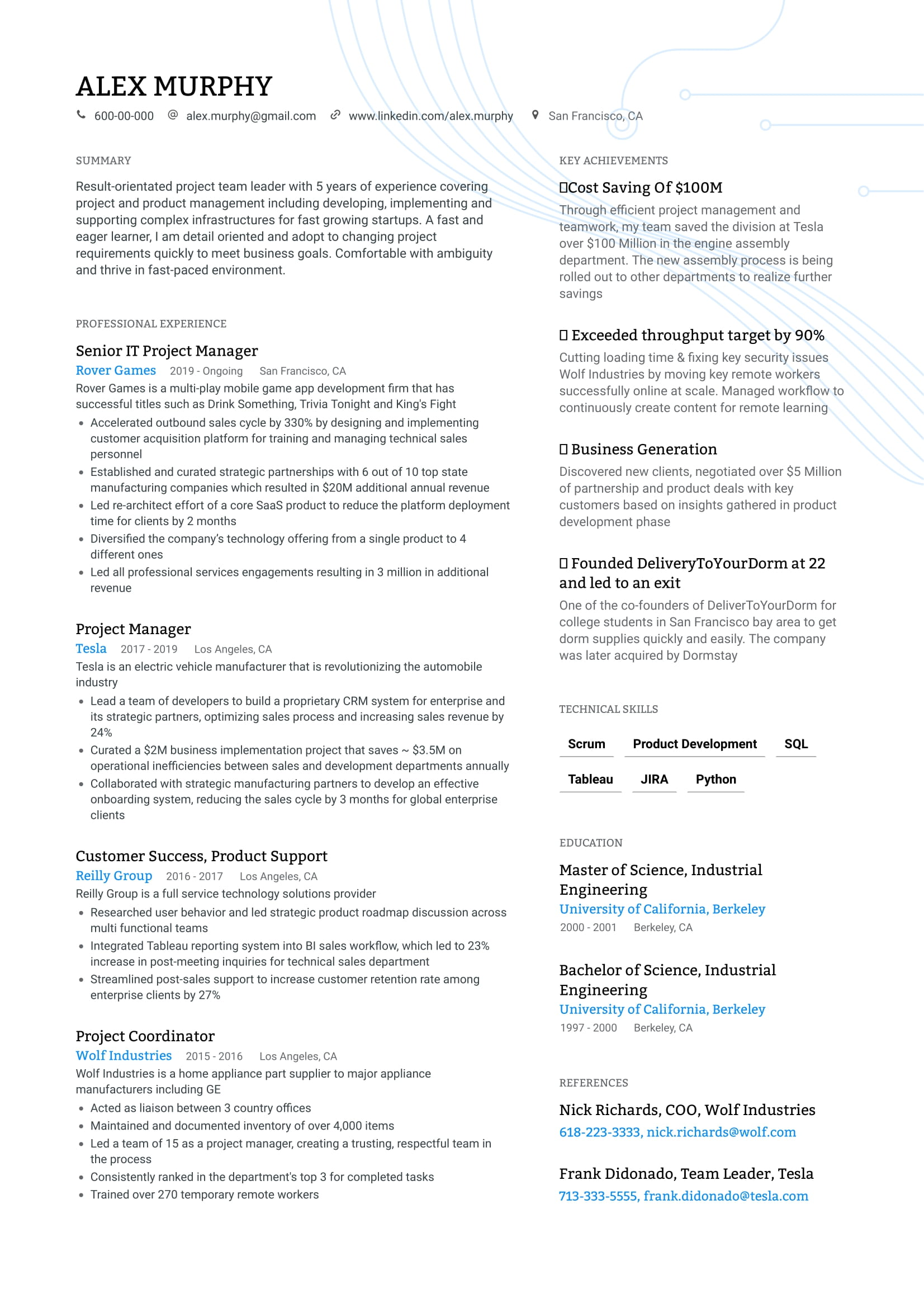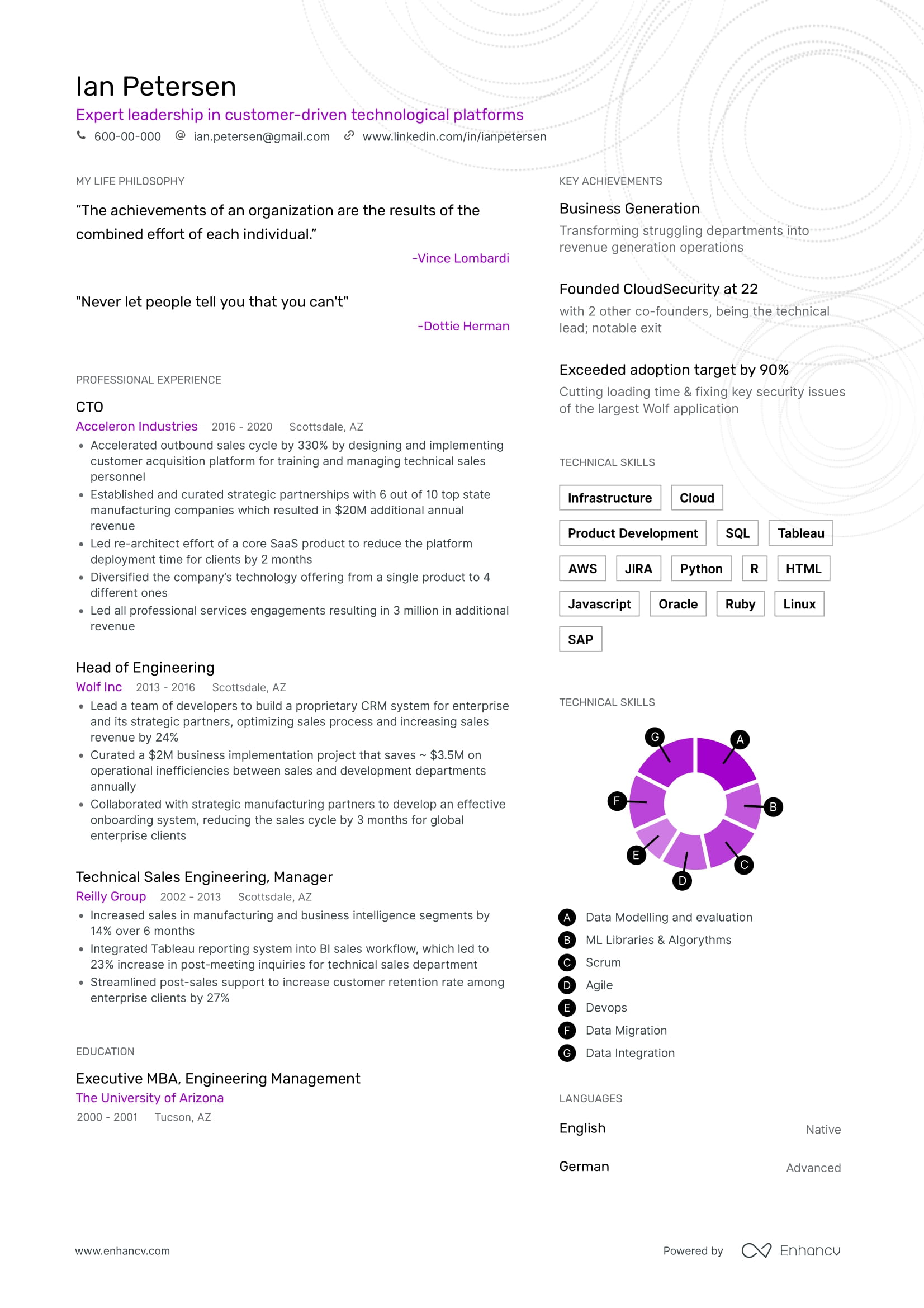Example Tech Resume - Browse more resume templates and build a stand-out resume
You find this tech job and start reading its description. Tech stack? Check. Team culture fit? Check. Benefits? Check. Next potential dream job? Check.
With all the tech skills you have on your technical resume, you think how qualified and even overqualified you are for this job.
You’ll run through the test assignment with the same speed as Usain Bolt before he went playing soccer.
But no assignment is coming your way. No callback. Not even an email. All you got is an auto-reply message from a job board.
The sad reality is, even the brightest engineers and developers don’t land job interviews simply because their tech resumes are not making the cut.
Even worse is that often your resume is doing rounds with several non-technical personnel before someone who knows the difference between IDE and API gets their hands on it.
But today we put an end to this nonsense. We’ll write a tech resume that will turn all these recruiters and gatekeepers into your most cheering advocates.
And here’s how.
What will you learn in this tech resume guide:
- how to write a technical resume that recruiters love to read from start to finish
- technical resume examples that land you job interviews, not waiting list subscriptions
- the difference between a good tech resume and a great tech resume with examples for every section
- technical resume template for maximum engagement and job invitations
Tech Resume Example
Looking for Related Resumes?
- IT Resume Example + Guide
- IT Project Manager Example + Guide
- Full Stack Developer Example + Guide
- Front End Developer Example + Guide
- Computer Science Example + Guide
How to Write a Job-Winning Technical Resume
You know what’s the difference between the tech skills section of someone who spent 10 years in front end development and someone who finished a Coursera webdev course yesterday?
None. Their “React.js”, “Angular”, “HTML”, and “Front End development” may look exactly identical.
And the same goes for back end developers, system administrators, and software engineers.
With the abundance of online courses, open-source project forks, and upwork gigs everyone can quickly learn the next hot framework or stack and even have some experience with it.
To write a job-winning tech resume that passes all the automatic and human filters with flying colors you need to account for one critical thing: context.
And the context of the IT recruitment scene is the following: you won’t impress recruiters with tech skills anymore.
Because everyone has them on their technical resumes.
So how do you stand out?
First, you need to demonstrate the impact of your work. Not just that you can do the work, but also that this work drives results.
You are as crucial to the success of your latest startup as that marketing guy whose name is on every PR release, so why not show it?
Second, create a narrative around your skills. This way you get to demonstrate your skills in action, but more importantly you’ll make your resume engaging for a non-technical recruiter.
Finally, perform deep research of your potential employers. Studying job requirements and the company's Glassdoor is cool, but is it enough?
People applying for Google are eagerly searching for the most recent interview puzzles and learning them by heart, so why not apply the same effort to your next dream job?
Learn as much as you can about the company you’re applying for -- what their website runs on, who are their lead engineers, what are their Github profiles, latest features, product history?
Victory loves preparation, and the more you know about the company, the better you can understand what will catch their eye and fast track you to the final round.
In this guide we’ll show you tech resume examples for every section of your resume, crafting a tech resume template that you can adapt to your needs right away.
Here are the most crucial sections of your technical resume.
Recommended layout for tech resume section
- Header section that grabs recruiter’s attention and facilitates positive expectations
- Experience section that is relevant and that demonstrates the ability to make impact
- Skills section with proper prioritisation and grouping of your tech and soft skills
- Education and Certification to strengthen your overall working profile
- Customs sections (Projects, Achievements) to stand out or fill gaps in your work history
What recruiters want to see in a good tech resume
- If you can use you your technical skills to drive results for a company
- If your technical skills are relevant and up-to-date
- If you have a thorough understanding of your future working environment
- If you can explain complex work processes even to a non-technical person
- If you know the value behind your work and ready to prove it
For more information on the best resume format options, read our guide:The Best Resume Formats You Need to Consider (5+ Examples Included).
Technical Resume Header Section: How To Instantly Make Recruiters Like You
Your technical resume starts with the Header section where you put your name, address, and contact details so that recruiters could reach out to you later.
Of course you could stop here and proceed to the next sections, but there’s something else you can do.
You see, 93% of recruiters will be reviewing your social media profiles before offering you a job.
And whatever recruiters find on your social profiles (post history, friends list, bio) can be interpreted in so many ways that it becomes a lottery of whether they will like you or not.
You don’t need to play this game. Guide recruiters with the links to your Github and Linkedin profiles, and let them see what you want them to see.
For technical positions, prioritise linking to your Github -- that way technical recruiters and project leads can quickly make an impression about you from the quality of your work.
If you’re going for an IT managerial position, prioritise Linkedin to demonstrate your connections and networking skills -- those are important skills for leaders that many candidates lack.
We’re also adding a custom headline because during our research we learned that the company we’re applying for is actively expanding their mobile development department.
If you want more ideas for stand-out resume headers, read through our guidePerfecting Your Resume Header so You Get Noticed.
IT/Tech Resume Experience Section: Conquering Recruiters and Employers With Impact and Results
The Experience section of your technical resume is where the majority of your research will pay off.
Have you found about the latest features the company was adding to their product? Are they pivoting, expanding, re-architecting?
Are they trying to make their product more stable, or are they in hot water pushing as many new features as they can before the funding dries up?
Whatever you learn, you can rearrange your previous experience and demonstrate that you will be a part of the solution.
The next step after you nail your research is to create a convincing narrative of your impact. Use this formula:
Accomplished [A] as measured in [B] by doing [C]
Bad example: helped developing X messaging platform
Good example: as a part of 3-engineer unit developed X messaging platform optimized for 10M+ daily active users.
Lastly, buzzwords and keywords. Any technical job description features both.
Examples of buzzwords: microservices, scalable computing, VR, A.I, etc.
Examples of keywords: functional programming, Python, AWS, etc.
It’s important to mention both in your resume for two reasons:
- Pass applicant tracking systems (ATS) that automatically filter out non-tech resumes
- Gain a competitive advantage over candidates who didn’t perform due research
If during your research you’ve found that a company uses a fresh technology and also mentions this tech in their job description, by all means find a way to weave it into your narrative.
Don’t lie if you don’t have experience with certain tech and don’t overdo buzzwords -- if you put all the recent IT buzzwords in your tech resume it will look unnatural.
For more ideas on how to create an actionable resume experience section, check out our guideHow to Describe Your Resume Work Experience.
Resume Skills Section: Do’s and Don'ts
Having a balanced Skills section is vital because it helps recruiters to understand whether you are able to perform the job.
But no one will be reading a list of 50+ skills that you've acquired over your career
Here are some tips to make your Skills section more engaging and impactful:
- Put the tech that the company uses higher on your list of skills
- Group your technical skills for better readability, e.g. “Programming languages”, “Platforms”, “Services”
- List only the most recent and relevant technology. Outdated technology may leave a poor impression
- Mention methodologies on par with frameworks -- the ability to work with teams that follows agile or DevOps workflows is as important as the skills you have
- Add some more buzzwords you weren’t able to include with the Experience section: DataOps, DevOps, VR/AR. But add only relevant skills, don’t over do it
- If you’re going for a leadership position, put the Soft Skills section before the Technical Skills section
Here are some of the hard skills to put on your technical resume:
Hard Skills for a Good Technical Resume
- Programming languages (C#, Java, Python, Scala, PHP, Javascript)
- DevOps (Ansible, Puppet, Docker, etc.)
- Cloud technologies (AWS, Azure, Google CLoud, IBM, etc.)
- Architectures (micr-services, scalable computing, distributed computing)
- Front End (React.js, Angular.js, Vue.jx, Ember.js, …)
- Back End (Django, Laravel, ASP.NET Core, Ruby on Rails, Flask, …)
- HTML, CSS
- SQL, noSQL
Let’s be honest: engineers are rarely hot for the soft skills section.
And recruiters are not that hot for generic “communication” and “problem solver” entries to this section either.
But here comes one of those great opportunities to transform something that is a liability into an opportunity.
Frame your Soft skills section as your “Achievements”.
Won a blockchain hackathon in 2019? Great way to demonstrate your quick thinking and creativity.
Spot an error in a corporate BI reporting system? That’s attention to details.
Launched an MVP with a small team of undergrads? Teamwork and resource management.
This section is also great for demonstrating your ability to work well within Agile teams, corporate cultures, or remote startups.
Just learn more about the company you’re applying for and you’ll see which soft skills you should double down on.
Here are some of the soft skills to put on your technical resume
Top 12 Soft Skills to List on Your Resume
- Agile methodologies
- Critical thinking
- QA
- Lean development
- Presentation & demonstration
- Team work
- Attention to details
- Analytical approach
- Strategic thinking
- Flexibility
- Creativity
- Quick learner
Are you still not sure what skills will win recruiters over? Check out our guide onHow to Create A Resume Skills Section To Impress Recruiters (+10 Examples You Need to See).
Resume Education & Certification Sections
The majority of technical positions require a bachelor degree in computer science or any related field.
But the more experience the technical position requires, the less education plays a role in your selection process.
If you’re applying for Senior Software Engineer, IT Manager, or any other job that requires years of experience, put the Experiences section on top of your tech resume template.
If you, however, apply for an entry-level technical position, make sure to format your Education section for the maximum impact.
In order to do that, put the most relevant coursework in the beginning. Mention your GPa if it’s above the average, and if it's less than 3.0 drop the number altogether.
If you have IT projects that you completed during your education, consider putting them in a separate Projects section of your tech resume.
Browse more essential tips on how to feature education on your resume, in our guidePerfecting the Education Section on Your Resume.
The Best Certificates For Your Resume
There are many certifications in the IT field, but there’s no reason to mention every one of them on your tech resume to impress recruiters.
Add only certificates that are highly relevant for the job or hard to achieve (such as Cisco Certified Internetwork Expert or Project Management Professional).
For more information on how to properly list resume certifications, we recommend reading our guideHow To List Certifications On A Resume (Examples Included).
Other sections to include on your resume
Depending on the company, job seniority level and your location, you may want to include more sections to your Tech resume:
Summary: Creating a Tech Resume That Stands Out
- Create a compelling narrative with your tech resume instead of simply listing your technical skills
- Stand out from your competition by demonstrating the impact of your professional work
- Use clever formatting to guide recruiters attention and make your technical resume easy-to-read and engaging
- Provide a context for your technical skills to demonstrate them in action and prove that you really possess them
- Go extra mile researching the companies you’re applying for to learn their preferences, goals, and challenges, and use this information to enrich your tech resume
